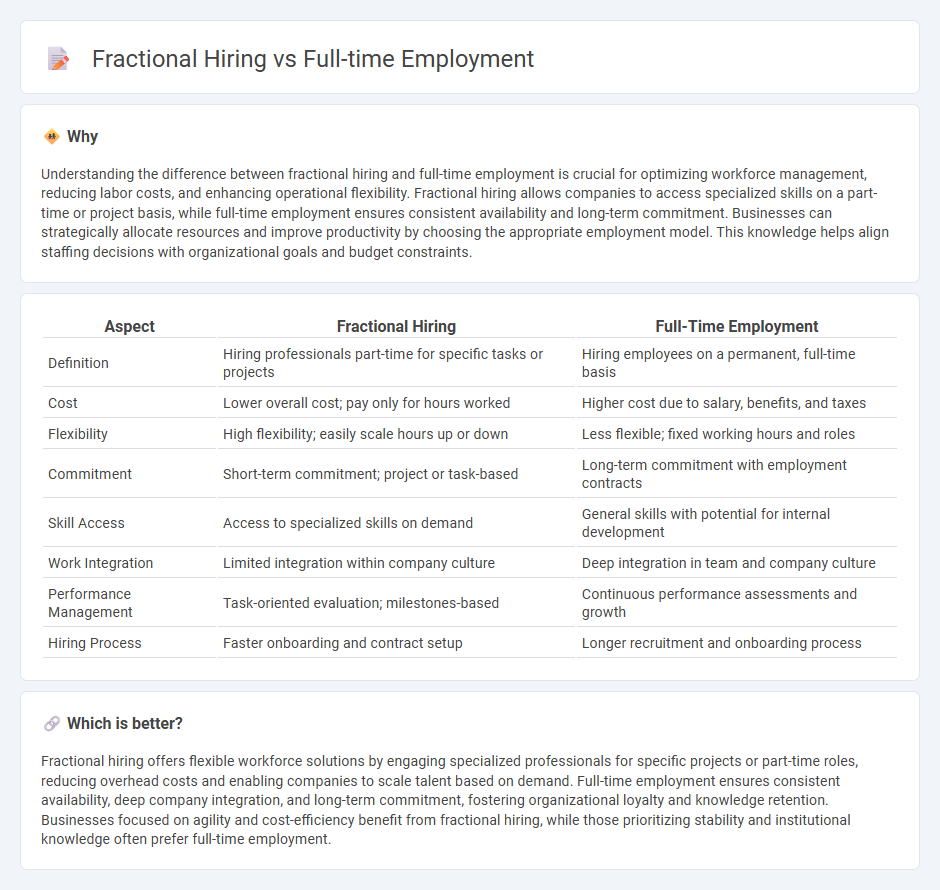
Fractional hiring offers businesses access to specialized skills on a part-time basis, reducing overhead costs compared to full-time employment. Full-time roles provide consistency and deeper organizational integration but often require higher financial commitments and benefits management. Explore how fractional hiring can optimize workforce flexibility and cost-efficiency for your company.
Why it is important
Understanding the difference between fractional hiring and full-time employment is crucial for optimizing workforce management, reducing labor costs, and enhancing operational flexibility. Fractional hiring allows companies to access specialized skills on a part-time or project basis, while full-time employment ensures consistent availability and long-term commitment. Businesses can strategically allocate resources and improve productivity by choosing the appropriate employment model. This knowledge helps align staffing decisions with organizational goals and budget constraints.
Comparison Table
| Aspect | Fractional Hiring | Full-Time Employment |
|---|---|---|
| Definition | Hiring professionals part-time for specific tasks or projects | Hiring employees on a permanent, full-time basis |
| Cost | Lower overall cost; pay only for hours worked | Higher cost due to salary, benefits, and taxes |
| Flexibility | High flexibility; easily scale hours up or down | Less flexible; fixed working hours and roles |
| Commitment | Short-term commitment; project or task-based | Long-term commitment with employment contracts |
| Skill Access | Access to specialized skills on demand | General skills with potential for internal development |
| Work Integration | Limited integration within company culture | Deep integration in team and company culture |
| Performance Management | Task-oriented evaluation; milestones-based | Continuous performance assessments and growth |
| Hiring Process | Faster onboarding and contract setup | Longer recruitment and onboarding process |
Which is better?
Fractional hiring offers flexible workforce solutions by engaging specialized professionals for specific projects or part-time roles, reducing overhead costs and enabling companies to scale talent based on demand. Full-time employment ensures consistent availability, deep company integration, and long-term commitment, fostering organizational loyalty and knowledge retention. Businesses focused on agility and cost-efficiency benefit from fractional hiring, while those prioritizing stability and institutional knowledge often prefer full-time employment.
Connection
Fractional hiring and full-time employment are connected through workforce flexibility and resource optimization, allowing businesses to scale their talent according to project demands and budget constraints. Fractional hiring provides specific expertise on a part-time basis, complementing full-time employees by filling skill gaps without the long-term commitment. This hybrid model enhances operational efficiency and supports dynamic staffing strategies in competitive job markets.
Key Terms
Work Hours
Full-time employment typically involves a standard 40-hour workweek with fixed schedules and full access to company benefits, fostering consistent productivity and team collaboration. Fractional hiring offers flexible, part-time work hours tailored to project needs, reducing costs while providing specialized expertise without long-term commitments. Explore how adjusting work hours can optimize your workforce strategy for greater efficiency and agility.
Compensation Structure
Full-time employment typically involves a fixed salary with benefits such as health insurance, paid leave, and retirement plans, providing financial stability and comprehensive compensation. Fractional hiring offers a more flexible payment model, often based on hourly rates or project milestones, allowing companies to optimize costs and pay strictly for the work delivered. Discover more about how these compensation structures can impact your hiring strategy and budget planning.
Employment Contract
Full-time employment contracts typically outline fixed working hours, comprehensive benefits, and long-term job security, reflecting a traditional employer-employee relationship with consistent responsibilities. Fractional hiring agreements focus on specific project deliverables, flexible schedules, and limited benefits, emphasizing results-driven engagement tailored to specialized skills. Explore detailed contract comparisons to determine the best fit for your workforce strategy.
Source and External Links
Full-time employment | EBSCO Research Starters - Full-time employment typically means working a minimum number of hours weekly, often 30 or more, with benefits like higher wages and health insurance, though definitions and laws vary by country and employer.
Full-Time vs Part-Time Employment Law: Key Differences - Full-time employees generally work 35 to 40 hours per week, receiving statutory protections and benefits including minimum wage, overtime pay, health insurance, and paid time off, depending on employer policies and laws.
What Is a Full-time Job? | Indeed.com - A full-time job usually involves about 40 hours weekly with benefits such as fixed salary, higher annual earnings compared to part-time jobs, and set working hours, offering more financial security and predictability.
 dowidth.com
dowidth.com